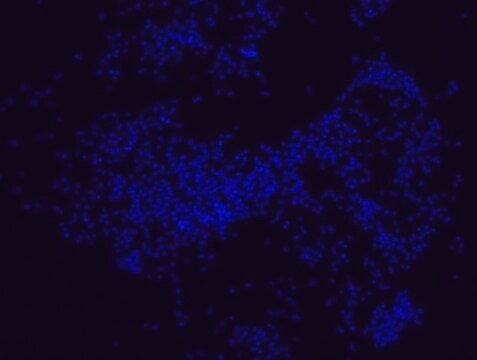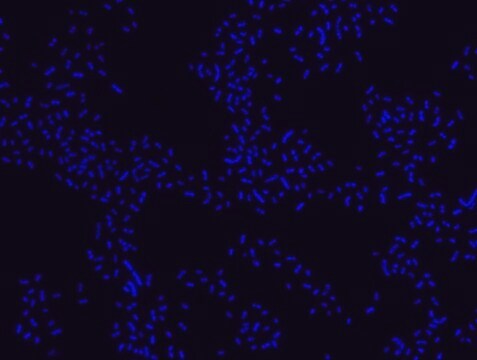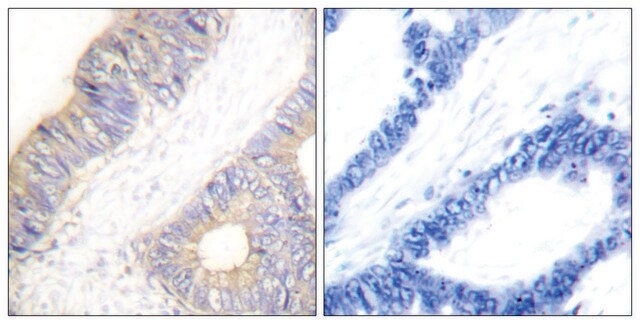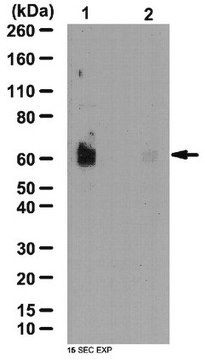Wszystkie zdjęcia(3)
Kluczowe dokumenty
MBD0028
Sonda FISH Porphyromonas gingivalis - ATTO488
Probe for fluorescence in situ hybridization (FISH)
Synonim(y):
POGI
Zaloguj sięWyświetlanie cen organizacyjnych i kontraktowych
About This Item
Kod UNSPSC:
12352200
NACRES:
NA.51
Polecane produkty
Poziom jakości
Formularz
liquid
stężenie
20 μM
metody
FISH: suitable
Warunki transportu
dry ice
temp. przechowywania
−20°C
Opis ogólny
Technika fluorescencyjnej hybrydyzacji in situ (FISH) opiera się na hybrydyzacji fluorescencyjnie znakowanej sondy oligonukleotydowej do określonej komplementarnej sekwencji DNA lub RNA w całych i nienaruszonych komórkach.1 Mikrobiologiczna FISH umożliwia wizualizację, identyfikację i izolację bakterii dzięki rozpoznawaniu rybosomalnego RNA również w próbkach niekulturowych.2
Technika FISH może służyć jako potężne narzędzie w dziedzinie badań mikrobiomu, umożliwiając obserwację natywnych populacji drobnoustrojów w różnych środowiskach mikrobiomu, takich jak próbki pochodzenia ludzkiego (krew3 i tkanki4), ekologia drobnoustrojów (stałe biofilmy 5 i systemy wodne6) i rośliny7. Zdecydowanie zaleca się uwzględnienie kontroli pozytywnych i negatywnych w testach FISH w celu zapewnienia specyficznego wiązania sondy będącej przedmiotem zainteresowania i odpowiednich warunków protokołu. Oferujemy sondy kontroli pozytywnej (MBD0032/33) i negatywnej (MBD0034/35), które towarzyszą konkretnej sondzie będącej przedmiotem zainteresowania.
Sonda Porphyromonas gingivalis specyficznie rozpoznaje komórki P. g ingivalis. P. gingivalis to gram ujemna bakteria, która jest czynnikiem etiologicznym zapalenia przyzębia u dorosłych, przewlekłej choroby zapalnej charakteryzującej się zniszczeniem tkanki podporowej otaczającej zęby. Badania wykazały, że LPS z P. g ingivalis odgrywa ważną rolę w tej chorobie.8-11 Zgłoszono związek mikrobioty jamy ustnej, w tym P. gingivalis, z różnymi stanami patologicznymi. Obejmują one rozwój choroby Alzheimera12, rolę w nowotworach jamy ustnej13, przedwczesny poród14 i reumatoidalne zapalenie stawów15. Technika FISH została z powodzeniem wykorzystana do identyfikacji P. gingivalis za pomocą sondy w różnych próbkach, takich jak czysta hodowla (jak opisano w legendzie rysunku), implanty dentystyczne16,17 , zmiany okołowierzchołkowe zębów18, ślina19, tkanka mózgowa20, tkanki dziąseł i aorty21, biofilmy z protez głosowych22, biofilm poddziąsłowy23, tkanka ściany aorty24 i zakażone komórki HeLa25. Co więcej, FISH może być wykorzystywana do identyfikacji P. gingivalis w tkance nowotworowej26, wielogatunkowym biofilmie27, wielogatunkowych biofilmach jamy ustnej28 oraz czystej hodowli i komórkach nabłonka policzka29.
Technika FISH może służyć jako potężne narzędzie w dziedzinie badań mikrobiomu, umożliwiając obserwację natywnych populacji drobnoustrojów w różnych środowiskach mikrobiomu, takich jak próbki pochodzenia ludzkiego (krew3 i tkanki4), ekologia drobnoustrojów (stałe biofilmy 5 i systemy wodne6) i rośliny7. Zdecydowanie zaleca się uwzględnienie kontroli pozytywnych i negatywnych w testach FISH w celu zapewnienia specyficznego wiązania sondy będącej przedmiotem zainteresowania i odpowiednich warunków protokołu. Oferujemy sondy kontroli pozytywnej (MBD0032/33) i negatywnej (MBD0034/35), które towarzyszą konkretnej sondzie będącej przedmiotem zainteresowania.
Sonda Porphyromonas gingivalis specyficznie rozpoznaje komórki P. g ingivalis. P. gingivalis to gram ujemna bakteria, która jest czynnikiem etiologicznym zapalenia przyzębia u dorosłych, przewlekłej choroby zapalnej charakteryzującej się zniszczeniem tkanki podporowej otaczającej zęby. Badania wykazały, że LPS z P. g ingivalis odgrywa ważną rolę w tej chorobie.8-11 Zgłoszono związek mikrobioty jamy ustnej, w tym P. gingivalis, z różnymi stanami patologicznymi. Obejmują one rozwój choroby Alzheimera12, rolę w nowotworach jamy ustnej13, przedwczesny poród14 i reumatoidalne zapalenie stawów15. Technika FISH została z powodzeniem wykorzystana do identyfikacji P. gingivalis za pomocą sondy w różnych próbkach, takich jak czysta hodowla (jak opisano w legendzie rysunku), implanty dentystyczne16,17 , zmiany okołowierzchołkowe zębów18, ślina19, tkanka mózgowa20, tkanki dziąseł i aorty21, biofilmy z protez głosowych22, biofilm poddziąsłowy23, tkanka ściany aorty24 i zakażone komórki HeLa25. Co więcej, FISH może być wykorzystywana do identyfikacji P. gingivalis w tkance nowotworowej26, wielogatunkowym biofilmie27, wielogatunkowych biofilmach jamy ustnej28 oraz czystej hodowli i komórkach nabłonka policzka29.
Zastosowanie
Sonda do fluorescencyjnej hybrydyzacji in situ (FISH), rozpoznaje komórki Porphyromonas gingivalis
Cechy i korzyści
- Wizualizacja, identyfikacja i izolacja komórek Porphyromonas gingivalis.
- Obserwacja natywnych populacji komórek P. gingivalis w różnych środowiskach mikrobiomu.
- Specyficzna, czuła i niezawodna identyfikacja P. g ingivalis w mieszanej populacji bakterii.
- Specyficzna, czuła i niezawodna identyfikacja nawet w przypadku niskiej liczebności P. gingivalis w próbce.
- FISH może uzupełnić metody wykrywania oparte na PCR, unikając wykrywania bakterii zanieczyszczających.
- Dostarcza informacji na temat morfologii P. gingivalis i umożliwia badanie architektury biofilmu.
- Identyfikacja P. gingivalis w próbkach klinicznych, takich jak tkanki nowotworowe i mózgowe (na przykład w utrwalonych w formalinie próbkach zatopionych w parafinie (FFPE)), ślina i jama ustna oraz sprzęt medyczny, taki jak implanty dentystyczne i protezy głosowe.
- Zdolność do wykrywania P. gingivalis w jego naturalnym środowisku jest niezbędnym narzędziem do badania interakcji gospodarz-mikrobiom.
Ta strona może zawierać tekst przetłumaczony maszynowo.
Kod klasy składowania
12 - Non Combustible Liquids
Klasa zagrożenia wodnego (WGK)
nwg
Temperatura zapłonu (°F)
Not applicable
Temperatura zapłonu (°C)
Not applicable
Wybierz jedną z najnowszych wersji:
Certyfikaty analizy (CoA)
Lot/Batch Number
It looks like we've run into a problem, but you can still download Certificates of Analysis from our Dokumenty section.
Proszę o kontakt, jeśli potrzebna jest pomoc Obsługa Klienta
Masz już ten produkt?
Dokumenty związane z niedawno zakupionymi produktami zostały zamieszczone w Bibliotece dokumentów.
Érika Gomes Sarmento et al.
Food research international (Ottawa, Ont.), 116, 1282-1288 (2019-02-06)
Probiotics are widely used in the food industry and may affect the oral microbiota. This study aimed to evaluate the effect of petit-suisse plus probiotic on the microbiota of children's saliva. Strawberry flavor petit-suisse cheese plus green banana flour without
Nadine Kommerein et al.
PloS one, 13(5), e0196967-e0196967 (2018-05-18)
Peri-implant infections are the most common cause of implant failure in modern dental implantology. These are caused by the formation of biofilms on the implant surface and consist of oral commensal and pathogenic bacteria, which harm adjacent soft and hard
Pia T Sunde et al.
Microbiology (Reading, England), 149(Pt 5), 1095-1102 (2003-05-02)
Whether micro-organisms can live in periapical endodontic lesions of asymptomatic teeth is under debate. The aim of the present study was to visualize and identify micro-organisms within periapical lesions directly, using fluorescence in situ hybridization (FISH) in combination with epifluorescence
Virulence factors of Porphyromonas gingivalis.
S C Holt et al.
Periodontology 2000, 20, 168-238 (1999-10-16)
Alice Harding et al.
Frontiers in aging neuroscience, 9, 398-398 (2017-12-19)
Longitudinal monitoring of patients suggests a causal link between chronic periodontitis and the development of Alzheimer's disease (AD). However, the explanation of how periodontitis can lead to dementia remains unclear. A working hypothesis links extrinsic inflammation as a secondary cause
Nasz zespół naukowców ma doświadczenie we wszystkich obszarach badań, w tym w naukach przyrodniczych, materiałoznawstwie, syntezie chemicznej, chromatografii, analityce i wielu innych dziedzinach.
Skontaktuj się z zespołem ds. pomocy technicznej








